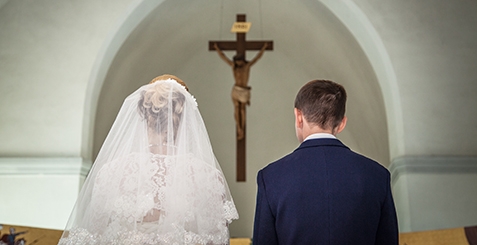Planning a Catholic Wedding

Nowadays many engaged couples handle a lot of their own wedding planning. When at least one of the individuals is Catholic this can include making arrangements to be married in a Catholic church. This is a significant decision. It means more than just choosing an appropriate and picturesque setting for the ceremony and the photos!
You’re trying to make your wedding a meaningful and memorable experience and, most of all, to express in a clear and beautiful way the hopes you have for your married life. How can you achieve these goals in the celebration of your wedding? Here are three general suggestions. You can find even more specific ideas on other parts of this website.
Take time to prepare and plan
Catholic dioceses in the United States have policies that require a preparation period of six months to one year for couples who want to be married in the Church. The preparation includes a contact with the parish in which they want to have their wedding. It’s a good idea to get your date on the parish calendar as soon as possible. It’s also important to talk with the parish priest or deacon or pastoral minister about what the parish allows and expects in a celebration. It is also possible that the parish can offer specific help and resources, such as a person to help you plan and coordinate the event.
Beginning early to work with the parish makes practical good sense and it also helps you to develop a relationship with a community that shares your faith and wants to support you in the sacrament you are about to receive and live. Quite likely you will be given some material about the Catholic wedding liturgy and encouraged to read and ask questions. Take the time to do this. It will enhance your preparation and help you to focus on the meaning of the commitment you are about to make.
Three forms of the Rite of Marriage
The Catholic Church provides three different forms of celebrating the Rite of Marriage. When two Catholics are marrying, the celebration will normally take place within a Mass. The second form, which does not include a Mass, is used when a Catholic marries another baptized Christian. There is a third form, which also does not include a Mass, for a Catholic marrying someone who is a non-Christian. You should choose one of these forms in conversation with the priest or deacon who will witness your marriage vows. Watch the video to learn more about the Rite of Marriage.
Take advantage of options
Within each of the three forms of the Rite, there are additional choices. For example, you can select biblical readings, blessings, and prayers from the approved texts. You can also choose friends or family members for different roles in the ceremony, such as readers and those who assist with the Eucharistic gifts and the distribution of Holy Communion. Making these choices with your future spouse and with the priest or deacon can help you to learn more about the Catholic understanding of marriage and to become more deeply involved in your celebration of it.
Take notice of the ritual
A very good way to know what the Catholic Church believes is to participate in its worship. This is especially true in the case of marriage. The Catholic marriage rite, whether it is celebrated within a Mass or not, is a powerful teaching tool. This is experienced in many ways, for example:
- in the active role taken by the couple who, in the teaching of the Roman Catholic Church, are the “ministers” of the sacrament;
- in the fact that the wedding takes place in a church, signifying it is a sacred action;
- in the scriptural readings which speak of God’s plan for marriage and his presence to the couple;
- in the music which lifts our thoughts and feelings in a prayerful, joyful way;
- in the homily given by the priest or deacon addressing the couple and their guests about the meaning of marriage as well as its joys and challenges;
- in the vows and exchange of rings in which the couple express their freely-given consent, promising to create a loving and lifelong union of permanence, fidelity, and openness to children;
- in the various prayers and blessings through which the Church solemnizes and supports the journey on which the couple is embarking.
Thoughtful, prayerful planning and participation in your Catholic wedding ceremony is a decision that will bring many blessings to your married life long after you’ve forgotten all the other decisions you made about flowers, photos, and favors on the tables!
For Further Reading:
- The Catholic Wedding Book: A Complete Guidebook by Molly K. Hans and Fr. William C. Graham




